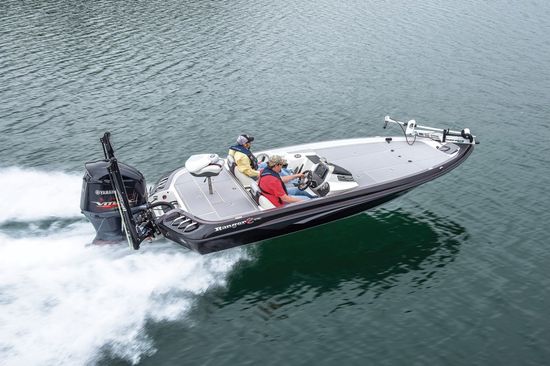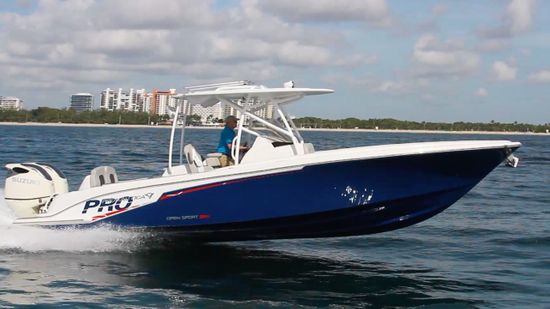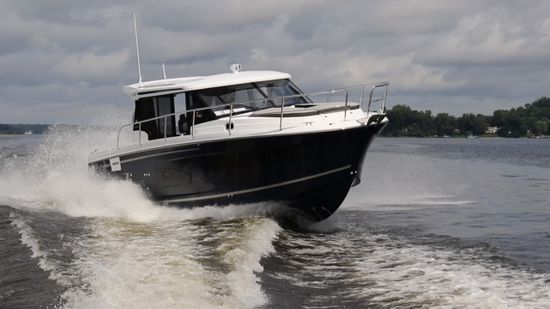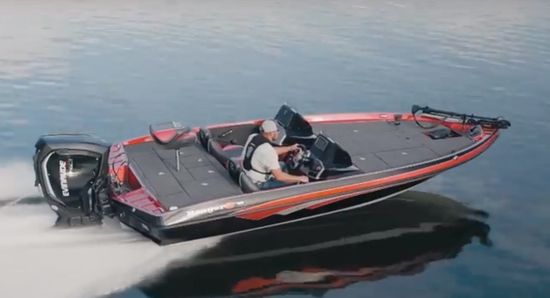High-Speed Boat Handling

You can tell your wife you bought the most horsepower for the resale value, but you can’t fool us: we know you just plain like to go fast. You’ll push off the dock at zero-dark-early and you’ll be the first one to the honey hole come hell or high water. Or, you might wait for a busy Sunday afternoon to rumble out of the harbor and then tear across the lake of the sound showing everyone that you are Mario Andretti of the waves.
Here is some advice from the Captains at BoatTEST-
First, know your limitations.
Boats going 60 mph are generally skiing along on a very small patch of their bottom. If the boat hits a wave just right – read: just wrong – it can roll the boat. We’re talking even large boats, such as 36-footers.
If the boat starts chine walking, do you know how to control it? When your boat soars off a wave and becomes airborne, do you have the presence of mind and the physical dexterity to both hold on and cut the throttles at the same time to keep from ruining the gears in your lower unit?
Will you be able to swerve, preferably without barrel-rolling your boat, in time to avoid a swimmer, a small boat, or a rock out of place?
a. Reaction time – For most captains, the reaction time between seeing an object in the water and taking evasive maneuvers is about two seconds – one to recognize the object and one to react on the wheel or throttle.
b. At 60-mph, you’ll travel nearly 176’ (54 m) before twitching the wheel.
c. If it takes you three seconds to react, or you’re going faster, you’ll be 264’ (80 m) from where you first saw the object in front of you.
What do these numbers tell you?
Focus your eyes far enough forward that you can react to something you see. If you’re focused 50’ (15 m) in front of the boat and traveling at 60-mph, it won’t really matter if you see anything or not. You’ll mow it down anyway, simply because your brain and your body can’t coordinate a response quick enough to prevent it. Instead, look far ahead, as you do when driving a car on the highway.
This is one reason why we like to have as many eyes as possible looking forward when traveling fast.
Second, you need to know your boat’s limitations.
Some are able to handle high speed better than others. This is a judgment call, one that varies from boat to boat and captain to captain. But here are some danger signals that will help you determine when your boat has crossed the line between fast and too fast.

a. Chine walking - If you start chine walking, note the speed and back off on the throttle immediately. You may still be able to go that fast, but next time try tucking in the drive a bit, first. If it still occurs, you’ve probably found the boat’s limitation.
Keep the hull in the water – Serious speedsters with the necessary horsepower can run a boat so its hull is literally out of the water and only the outdrive and prop are wet. It’s a great way to go faster, but a lousy way to stay safe. Leave this course of action to the race drivers (who regularly buy the farm every year or so) and keep your hull in the water, where it belongs.

b. Porpoising - Your boat is porpoising? (An up-and-down motion, usually initiated by a wave, that continues long after the wave is gone.) That might mean you’ve applied excessive positive trim. Try bringing the drive back down a hair or bring down the tabs. When you don’t want to lose a fraction of a mph and you start porpoising, goose the throttles for a second then bring them back to their former position. The additional forward thrust will often stop the hop.
c. Catching air – When airborne and you hear your engines over-revving, cut the throttle - while being sure not to yank it into reverse. There is a reason why race boat drivers have a throttle man – his sole job is to listen to the engines and instantly cut the throttle when the props are out of the water. Lower unit gear failure is still the most common reason race boats drop out.
d. Prop cavitation – If the props start sucking air (ventilation), the boat will lose both speed and control. Go-fast aficionados know that in most cases when entering a high-speed turn, you’ll need to bring the drive in a hair to prevent the props from blowing out. Bring it in too far and you’ll bleed off a lot of speed.
Third, be ready for the unknown.
You need to know how to react to specific situations you’re likely to encounter in a high-speed run. Surprise waves, for example, call for specific reactions. Surprise rocks call of another. Floating debris requires a third action. Another high-speed boat coming your way necessitates yet a fourth.

Unexpected encounters – Let’s say you’re running full-tilt when an out-of-nowhere larger wave appears off the bow. You think you glimpsed something floating on the other side of that wave — maybe a log, big enough to do some serious damage if you hit it. Should you: a. Yank back on the throttle? or, b. Nail it, then pull it back? or, c. Turn the wheel hard over to port, or, d. Turn it hard to starboard?
What should you do?
Each situation is different. And you need to plan in your mind what to do for each of them.

Smaller boats - Often smaller boats and bass boat builders will design their hulls so that the flat chines run farther forward than usual, and add forefoot strakes on either side of the keel. These tweaks help the hull maintain its grip on the water, so bringing down the trim isn’t necessary and the boat remains in control through the turns. In fact, trimming the drive in while turning a bass boat can be dangerous - take it too far and you might stuff the bow.
The Bottom Line.
There is a reason that the USCG limits PWCs to 65 mph in normal recreational use – hitting the water any faster can be fatal. In fact, we have read about passengers falling overboard at less than that speed and being killed.

Worse is hitting another boat or object. Driving fast at night is what regular readers know we call the “Midnight Killer.” Each year, people are killed running into breakwaters, pilings, barges, and even islands that they did not see at night.
Our recommendation.
When you feel the need for speed, pick your water carefully. Be mindful of other boats and steer behind them. Look as far ahead as possible for debris, swimmers, kayaks, and anything else that might be trouble. Finally, pay attention. This is not a time to be cool, casual, or nonchalant. That is strictly for the movies. Remember, two seconds of inattention is 176’(54 m) of travel.